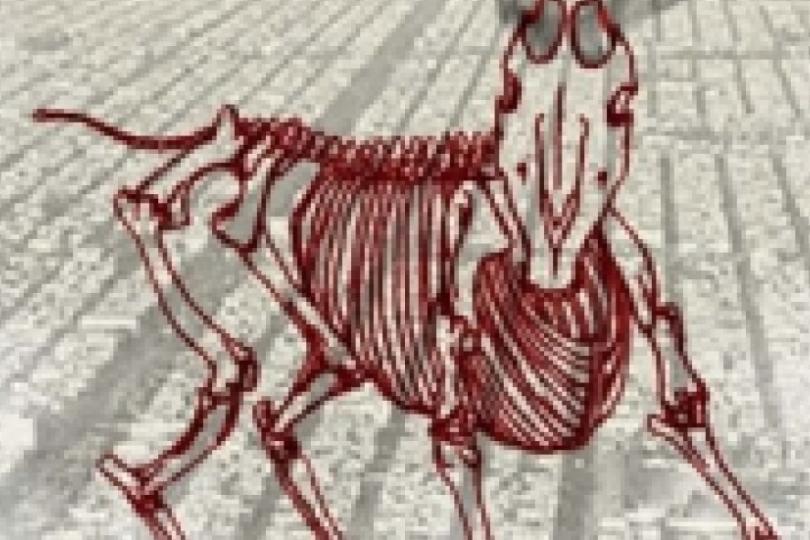Best of 2012-2013: 'Hidebound'
Editorial

Puppets.
This is where some of you cheer, and the rest of you moan. Read on, Unbelievers. My thoughts about Alison Heimstead's Hidebound may disappoint both camps. I don't care. This is not about Puppets. This is about Art.
Personal taste sometimes needs to be taken down a notch. Best, worst, blah blah blah. Art is like plumbing: necessary, a skilled labor, potentially messy, and often relegated to the dark places. It is also like sex: necessary, a skilled labor, potentially messy, and often relegated to the dark places. On other words, it's not really about whether the pipe is shiny, it's about whether it holds water. Let's stop saying so much about what we like, and start talking about how stuff works. How else can we improve, both as artists and as audiences?
I brought my teenager to Hidebound, one of a series of seventeen plays Erik Ehn wrote as a durational performance event called Soulographie: Our Genocides, a commemorative performance cycle. Hidebound premiered in October 2012 at In the Heart of the Beast and joined sixteen other international artists at LaMaMa in New York the following month for the whole Soulographie experience. If you're thinking, "Grim. Didactic. Puppets," think again, bright angel. At least as far as Ms. Heimstead's work. Her piece is an exciting, dynamic, complex, and multivalent piece that consciously manipulates interactions of object and bodies to open news ways of thinking about a range of issues including colonialism, genocide, and the obligations of history. And yes, it is a puppet show. Was it enjoyable? That's beside the point. It is effective at what it does, whether you enjoy it or not.
In the dark, Hidebound opens with a series of objects illuminated by a series of isolated lights. The objects remain mysterious, their location in space uncertain, their status as symbol, prop, puppet, or talisman unclear. What are we seeing? What is our place?
As Matt Larson's low, thrumming score begins, Julian McFaul begins to speak Erik Ehn's poetic text, "West Texas/Conquistador/Biologic War…" Okay, then: it’s a soundscape piece. Something to look at while we listen, or listen to while we look: observational, distant, indirect. No?
No. One of the last of these objects illuminated in this sort of live slideshow is a large bone. Suddenly it is touched by a human hand (Gustavo Boada) that then takes a small brush to it as if cleaning it from an archeological site. The bone changes. Where it was at first an object, something to look at, something to admire or interpret, in its handling it becomes something else. In being manipulated it's becoming an artifact. This is an implacable gesture, pulling us into a fascinated uncertainty, and we drown in its implications.
This opening move with the bone turns the images we are seeing into an archive, a record of authorized first things. These objects are on display as if in a museum. They are framed. Yeah, you see? Now we're getting into colonization, appropriation, history, right? Everything you thought you'd get from a lecture. But it's no lecture, baby. We can ask: who is recording? Where does the object come from? Who is the authority? Who owns what? And how did this bone lose its flesh? But we are not given answers to these questions, the truth is not laid out for us in our own language. And in this way we are both implicated in the image's materiality and kept at a distance from its voice. We are the ignorant in search of answers. We are colonists writing our own names on the face of the Other.
Had there been an interpretation of this opening image, had this been an introduction, an exposition for a narrative that we would follow to revelation and catharsis, we would be no better off. In fact, had this been a conventionally told puppet story of the conquistadors' echoing rampage, by the nature of its very structure it would merely repeat the evil it hoped to expose. Heimstead's brilliance, in part, is her use of puppetry, object, installation, movement, poetry and music to create an intriguing and fundamentally disarranging experience around our ideas of belonging.
The bone can serve as a model for other things here. It is an old-made-new-old object. We know what bone is. There's nothing new there. But in its placement in the performance it is made new. Art will do that. But it is not new-new. Its image is not a direct representation of something immediate and new to us (as it was when the proto-human picked it up and bashed things with it in the movie 2001: A Space Odyssey). It is now something different. It is old-new. It is something from some other place, and/or some other time. This old-newness is its otherness. It doesn't belong to us.
When later in the piece, the Bar-B-Q-Eaters line up behind the table (itself an old-made-new-old object hammered out of old cans and metal), the puppeteers (Steve Akerman, Gustavo Boada, Bart Buch, Blake Love) are wearing heavy brown aprons and boots, manipulating bunraku-style brown-skinned men who are themselves manipulating rib bones into Styrofoam clamshell food containers on what amounts to an assembly line, the end of which is marked by a small television monitor showing footage of an actual restaurant worker preparing ribs. The puppeteers are singing Larson's song "Too Much Running Around" as they work the line – working puppets, working an assembly line (am I reading too much art-labor critique into this part?). One places a rib in the clamshell, one squirts the rib with sauce. Another closes the clamshell, and the final worker carries it to the edge of the table and dumps it off the edge towards the monitor. It is the little men singing while they work.
Before long, however, the first puppeteer (Blake Love) grabs his puppet with a pair of tongs and spreads him in the clamshell. One by one, the little men are placed in food containers, squirted with sauce, and packaged by the bigger men. Although little has changed, now it is the puppeteers who are singing while they work, stuffing the defunct bodies of their puppets into Styrofoam packages. They move to the front of the table and sit on its edge, their lunches on their laps. Love gently lifts his puppet out of the clamshell and takes a bite. This was more disturbing than you might think. The other little men realize that they are being eaten and begin to chant and drive the semi-cannibal under the table. Arising from the floor Love is now wearing a papier-mâché horse head and is corralled by the bunraku-style small men on top of the table/counter.
Then on a platter from the darkness, a green papier-mâché hand lands on the table. Gustavo Boada stands, tentatively grabs the hand and, as if compelled, places it on his own hand. With this hand he subdues the horse, reaches into its belly and pulls out a long rope of gold. Brilliant.
Maybe the meaning is too clear in my description here because my language comes from my interpretation and my interpretation comes from my experience. It doesn't matter: in performance, this clarity and certainty is impossible. Only in retrospective analysis does the abstract connection of the equine and gold make a narrative sense. Only in retrospect can the donning of the hand be thought of as arming oneself with both a weapon and an excuse. Only in reflection do the rapidly shifting roles of oppressor and victim reveal their positions of mutual consumption. In the moment of experience, these images act on the imagination and the gut. The brilliance is in keeping these evocative images from losing their abstract connection to the complex truths they link to.
As if to underline this abstraction: immediately following the extraction of gold from the horse, Julian McFaul's voice returns with Erik Ehn's words:
Conquistador approaches the bar-b-q shack down. He comes down from out of the rain. He is a container truck. He carries three human heads by their hair. The eaters circle their shoulders around their food. He sleeps with all their wives.
Do you see? The images are jarring, the language butts up against the objects and the visuals, nothing matches, but everything goes together. And so here I am trying to convince you of Hidebound's clarity at the same time that I work to maintain its ineluctable mystery. What's up with that? Without getting too far into the role language and power play in art criticism, I'll just say that this complex combination in Heimstead's Hidebound is not only part of its power – it is intensely part of its meaning, and its unflinching responsibility.
Alison Heimstead's Hidebound is an excellent model of responsibility in art. Not in being responsible to funders or producers, a political agenda or cause, nor to an aesthetic, form, or style – in fact, its potential irresponsibility (or at least its refusal to pay lip service) to these demands are part of what make it responsible art.
As Hidebound makes clear, Heimstead has a thorough understanding of the history and conventions of the field in which she works, but is not beholden to their restrictions. In fact – and crucially – she abandons them. She betrays convention and abandons all comforting markers of identification. In their tired place she is able to craft us something rich, fierce, new, and entirely exciting.
I loved it and so did my son.




